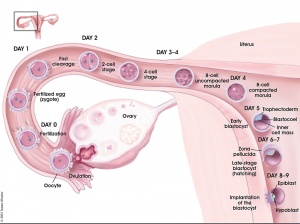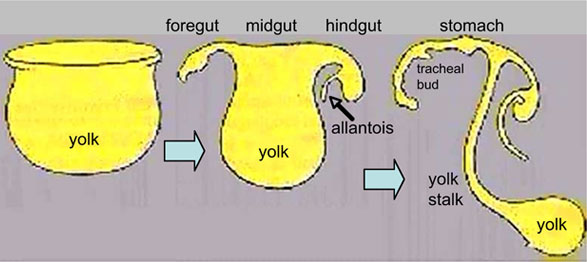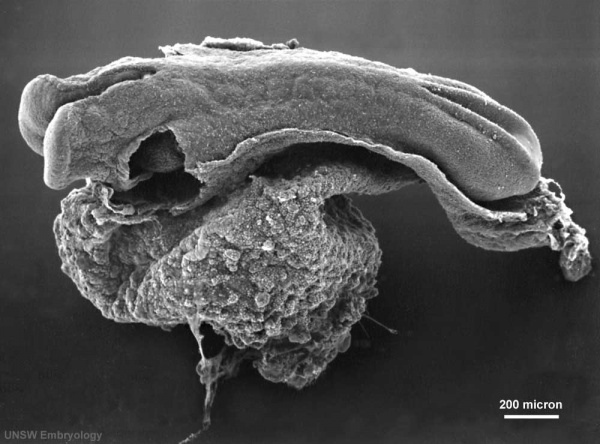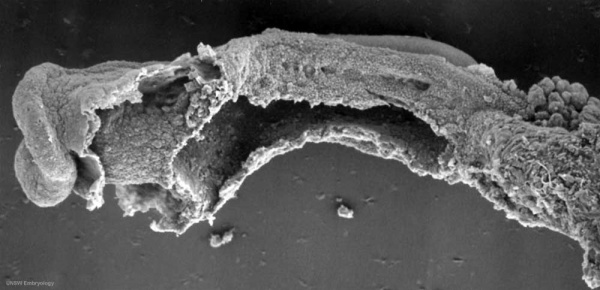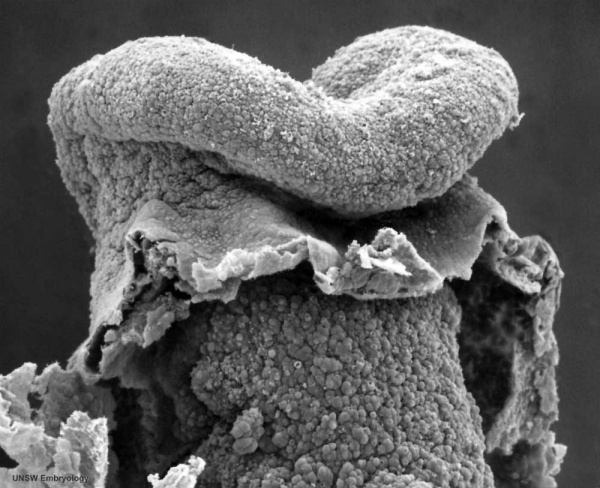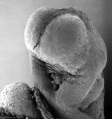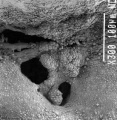BGDB Gastrointestinal - Trilaminar Embryo: Difference between revisions
| Line 78: | Line 78: | ||
[[File:Mesoderm_cartoon4.gif]] | [[File:Mesoderm_cartoon4.gif]] | ||
The cartoon above is a section through the trunk of the trilaminar embryo showing the further development of the 3 layers and the space (coelom) that forms in the mesoderm (only the righhand side is shown). | The cartoon above is a section through the trunk of the trilaminar embryo showing the further development of the 3 layers and the space (coelom) that forms in the mesoderm ('''only the righhand side is shown, lefthand side would be identical'''). | ||
Within the embryonic disc lateral plate mesoderm a space (coelom) forms, it lies within the embryo and so is called the intraembryonic coelom. This single "horseshoe-shaped" space will form the 3 major body cavities: pericardial (around the heart), pleural (around the lungs) and peritoneal (around the GIT and visceral organs). | Within the embryonic disc lateral plate mesoderm a space (coelom) forms, it lies within the embryo and so is called the intraembryonic coelom. This single "horseshoe-shaped" space will form the 3 major body cavities: pericardial (around the heart), pleural (around the lungs) and peritoneal (around the GIT and visceral organs). | ||
Revision as of 14:13, 2 May 2011
| Practical 1: Trilaminar Embryo | Early Embryo | Late Embryo | Fetal | Postnatal | Abnormalities | Lecture | Quiz |
Introduction
Begin by very briefly covering the first 3 weeks of development. Our story of GIT development begins in the third week with the formation of the 3 germ cell layers, one layer the endoderm will form the lining of the entire gastrointestinal tract and also contibute the respiratory tract and other organs.
Note that the description below, and throughout the practical, has been substantially simplified.
Week 1 and 2
Fertilization/Blastocyst Formation: an egg released into the uterine tube has been fertilized by a single sperm to form the first diploid cell (zygote). This cell then undergoes rapid division to form first a solid ball of cells (morula) and then a hollow ball (blastocyst) with an outer cell layer, an inner cell mass and a fluid filled cavity. All this has occurred in the uterine tube (horn, oviduct, fallopian tube) prior to implantation in the uterus.
<Flowplayer width="640" height="186" autoplay="true">Week1_001.flv</Flowplayer>
Week 3
Gastrulation/Neuralation: The inner cell mass forms a flat sheet of cells and cells migrate through a specific region of the sheet (primitive streak) turning the single layer into first 2 then 3 layers (trilaminar embryo).
Folding
The next process to follow is the folding of the embryonic disc which will form the "tube" of the GIT. Forming the ends of this tube are the 2 membranes which form the upper and lower limits of the GIT.
Note that in addition to gastrulation, neuralation (forming the early neural tube that makes the nervous system) and somitogenesis (segmentation of the mesoderm forming the axial skeleton) are the other major processes occuring in week 3 to 4.
Folding of the embryonic disc occurs ventrally around the notochord, which forms a rod-like region running rostro-caudally in the midline.
In relation to the notochord:
- Laterally (either side of the notochord) lies mesoderm.
- Rostrally (above the notochord end) lies the buccopharyngeal membrane, above this again is the mesoderm region forming the heart.
- Caudally (below the notochord end) lies the primitive streak (where gastrulation occurred), below this again is the cloacal membrane.
- Dorsally (above the notochord) lies the neural tube then ectoderm.
- Ventrally (beneath the notochord) lies the mesoderm then endoderm.
The ventral endoderm (shown yellow) has grown to line a space called the yolk sac. Folding of the embryonic disc "pinches off" part of this yolk sac forming the first primative GIT.
| File:Endoderm 002 icon.jpg</wikiflv> | Week3_folding icon.jpg</wikiflv> |
| Quicktime | Flash |
Quicktime | Flash |
Week 4
Carnegie stage 10, 23 day, 5-11 somite pairs
Membranes
During the process of gastrulation the embryonic disc formed 3 layers, except in 2 specific membrane regions where ectoderm and endoderm have no mesoderm between them: buccopharyngeal membrane and cloacal membrane. These will form the upper and lower extend of the GIT.
Buccopharyngeal membrane
also called mouth or oral membrane
Carnegie stage 10 (21 days, 4-5 somite pairs, ventral sem)
Carnegie stage 11 (25 days, 20 somite pairs)
Cloacal membrane - not clearly visible in the above section
Splanchnic Mesoderm
The cartoon above is a section through the trunk of the trilaminar embryo showing the further development of the 3 layers and the space (coelom) that forms in the mesoderm (only the righhand side is shown, lefthand side would be identical).
Within the embryonic disc lateral plate mesoderm a space (coelom) forms, it lies within the embryo and so is called the intraembryonic coelom. This single "horseshoe-shaped" space will form the 3 major body cavities: pericardial (around the heart), pleural (around the lungs) and peritoneal (around the GIT and visceral organs).
The mesoderm adjacennt to the endoderm is now called the splanchnic mesoderm which forms the connective tissue and muscular wall of the GIT.
Note intraembryonic coelomic cavity communicates with extraembryonic coelom (space outside the embryo) through portals (holes) initially on lateral margin of embryonic disc.
| Practical 1: Trilaminar Embryo | Early Embryo | Late Embryo | Fetal | Postnatal | Abnormalities | Lecture | Quiz |
BGDB: Lecture - Gastrointestinal System | Practical - Gastrointestinal System | Lecture - Face and Ear | Practical - Face and Ear | Lecture - Endocrine | Lecture - Sexual Differentiation | Practical - Sexual Differentiation | Tutorial
Glossary Links
- Glossary: A | B | C | D | E | F | G | H | I | J | K | L | M | N | O | P | Q | R | S | T | U | V | W | X | Y | Z | Numbers | Symbols | Term Link
Cite this page: Hill, M.A. (2024, April 16) Embryology BGDB Gastrointestinal - Trilaminar Embryo. Retrieved from https://embryology.med.unsw.edu.au/embryology/index.php/BGDB_Gastrointestinal_-_Trilaminar_Embryo
- © Dr Mark Hill 2024, UNSW Embryology ISBN: 978 0 7334 2609 4 - UNSW CRICOS Provider Code No. 00098G
